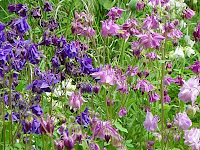 Ta-Dah!
Ta-Dah!
I made those, I did!
They're not exactly straight and they're not exactly level - but if anyone has a problem with that, there's a shovel and a sledgehammer in the shed - be my guest!
Looks a bit different to the original plan... Because once I had dug it, and laid out the border, it became apparent that I wouldn't be able to reach the middle of it. I had allowed a 30cm pathway between the rows of squares, thinking this would be enough to walk across the bed to reach the central squares for weeding - but forgot that weeding involves not only walking, but also kneeling down, which takes up more space (doh!). So I have taken out the central row and made a proper path, and my one large bed is now two smaller ones.
Luckily, my original crop rotation sudoku grid had a row of three squares at the bottom which didn't fit into an internal rotation set, so I took them out, and shifted the other rows accordingly.
Here's the new Sudoku Grid (Killer version - includes over-wintered, early and follow-on crops):
 Very glad I realised I needed to do this before I'd filled the bed with soil!
Very glad I realised I needed to do this before I'd filled the bed with soil!
Maths has never been my strong point, and somehow, I managed to mis-calculate how much soil I needed by a vast amount. I don't know what I missed out in my area-to-volume calculation, but it was obviously a bit key...
I reckoned that the 1/3 vermiculite, 1/3 compost, 1/3 peat-substitute mix needed 60 litres of each ingredient for the whole of the bed as originally planned. As it turned out, this didn't even fill one of the smaller ones... The soil in them now is thus a little less "Mel's mix" than "Contrary Mary's Whatever-was-to-hand mix".
For the record, each bed now contains:
100 litres Sainsbury's Multi-purpose compost
70 Litres J.Arthur Bowers Cocoa Shell
150 litres Homebase Enriched Peat-Free Compost
60 litres Vermiculite
Or, to put it another way, a grand total of 580 litres more stuff than I thought. And the proportions are completely blown. Never mind. We'll see how it goes, eh?
 It is in no way the gravel-free plant paradise it ought to be for the amount of work I've done on it. See that pile along the base of the wall? The stuff that looks like a heap of mud? That's not from the digging I was moaning about last week. That's just what came out with the
It is in no way the gravel-free plant paradise it ought to be for the amount of work I've done on it. See that pile along the base of the wall? The stuff that looks like a heap of mud? That's not from the digging I was moaning about last week. That's just what came out with the























